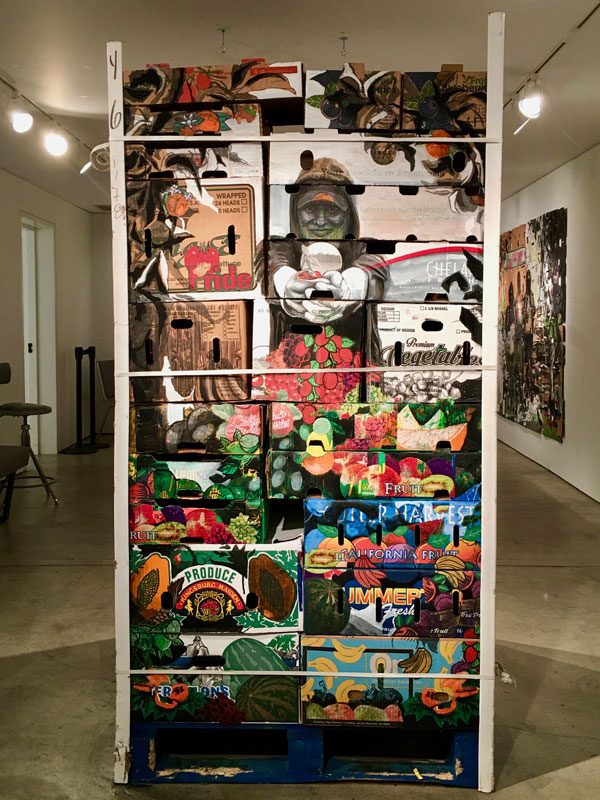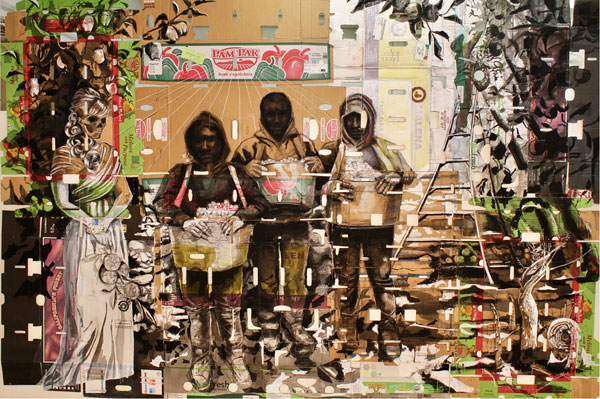Narsiso Martinez shapes richly detailed images of farm workers in oil, charcoal and ink wash—with discarded produce boxes as his canvas. A simple trip to Costco for pizza proved revelatory for the artist, when he found a purple-and-yellow banana box at the store. When drawing on that material, his spare and beautiful work evolved.
The artist combines images of the people who bring produce to consumers with the containers that transport this produce. The result is work that is both politically potent and deeply intimate, a look at farm workers that is engaging, insightful and poignant.
Born in Oaxaca, Mexico, the Long Beach–based artist came to the U.S. as an agricultural worker himself 20 years ago, and is currently completing his MFA at California State University Long Beach.
Initially, he simply liked the color of the cardboard combined with black and white charcoal, but almost immediately he realized that he was bringing the farm worker and ranch owner into the same conceptual space.

Premium Harvest (side one), 2016, ink, gouache, charcoal and collage on produce cardboard boxes, 70 x 65 x 19.5 in.
“I learned how agribusiness, through the spectacularization of products, pretty much erases the farm workers from the process, and their contributions are not acknowledged,” he said when I contacted him by phone. “Through the juxtaposition of the images of farm workers on produce boxes and the labels printed on those boxes, I want viewers to be aware of the inequity of the situation and learn a bit about the contributions of the farm workers to the nation.”
The artist once focused on landscapes. “I was working in the fields of Washington state picking fruit,” he tells me. “I thought the blossoming of the trees in the orchards as seen from far away was beautiful. I painted asparagus fields, apple and cherry orchards along the Columbia River. Sometimes I would include a farm worker or two in the distance.”
His last painting from this period, “99 +1,” was inspired by the Occupy Wall Street movement. It includes a banquet scene, an asparagus field, and a few workers. “I think that was the moment I became more interested in the actual farm workers,” he notes.

Friends in Freshness (1 of 4 sides), 2017, ink, gouache, charcoal and collage, on produce cardboard boxes, 78 x 40 x 48 in.
As perfectly detailed as his figurative drawings are, he works with immediacy directly onto his cardboard “canvas.” According to the artist, “I have to decide, as I go along with the drawing, how much of the original image on the box I want to expose and how much I need to cover up. A great part of the finished piece is just invented pattern, whether created with charcoal, gouache or collage images from other boxes.”
Some of his workers’ faces are obscured by hats, hoodies and scarves worn to ward off the dust and biocides of the fields; other images show the rigors of work in tired eyes. Combining an intensely personal narrative with social relevance, Martinez creates a passionate depiction of a world both familiar and forgotten. He explains, “In my work, I’m exploring the class distinctions and the injustices that come with them. I intend for these drawings to be the platform for discussion about inequities, and to point out the unfortunate circumstances of some social groups, like the farm workers, in contrast to the people who are profiting from those circumstances.”


